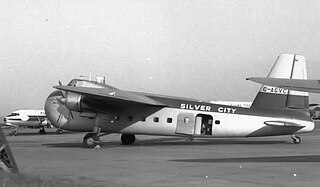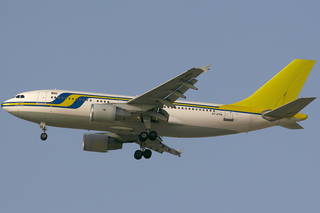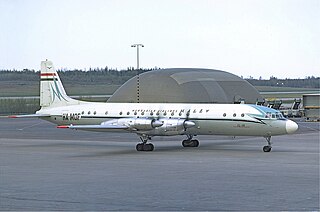
An aviation accident is an event during aircraft operation that causes serious injury, death, or destruction. An aviation incident is any operating event that compromises safety but does not progress to an aviation accident. Preventing accidents and incidents is the main goal of aviation safety.
This is a list of aviation-related events from 2000.

Sosoliso Airlines Flight 1145(SO1145/OSL1145) was a scheduled Nigerian domestic passenger flight from Nigeria's capital of Abuja (ABV) to Port Harcourt (PHC). At about 14:08 local time on 10 December 2005, Flight 1145 from Abuja crash-landed at Port Harcourt International Airport. The aircraft, a McDonnell Douglas DC-9-32 with 110 people on board, slammed into the ground and burst into flames. Immediately after the crash, seven survivors were recovered and taken to hospitals, but only two people survived.

Progress Multi Trade Air Flight 241 was a scheduled domestic passenger flight from Siem Reap to Sihanoukville, Cambodia. The flight was operated by regional airliner PMTair using an Antonov An-24. On 25 June 2007, the Antonov An-24, registered as XU-U4A, disappeared over the Cambodian jungle near Bokor Mountain in Kampot while on approach to Sihanoukville. A massive search and rescue operation ensued with thousands of soldiers and police scoured the area. The aircraft was found to have crashed in southwestern Cambodia, northeast of Dâmrei Mountains. All 22 people on board, most of whom were South Korean tourists, were killed. It remains as the second deadliest air disaster in Cambodian history.

The Winter Hill air disaster occurred on 27 February 1958, when the Silver City Airways Bristol 170 Freighter G-AICS, operated by Manx Airlines on a charter flight from the Isle of Man to Manchester, England, crashed during heavy snow into Winter Hill, 5 miles (8.0 km) southeast of Chorley. Thirty-five people died and seven were injured; the cause was determined to be navigational errors.

Sudan Airways Flight 109 was a scheduled international Amman–Damascus–Khartoum passenger flight, operated with an Airbus A310 by the flag carrier of Sudan, Sudan Airways. On 10 June 2008, at approximately 17:26 UTC, the Airbus A310 crashed on landing at Khartoum International Airport, killing 30 of the 214 occupants on board.

Yemenia Flight 626 was a flight on an Airbus A310-324 twin-engine jet airliner operated by Yemenia that was flying a scheduled international service, from Sana'a in Yemen to Moroni in Comoros, when it crashed on 30 June 2009 at around 1:50 am local time while on approach to Prince Said Ibrahim International Airport, killing all but one of the 153 passengers and crew on board. The sole survivor, 12-year-old girl Bahia Bakari, was found clinging to wreckage after floating in the ocean for thirteen hours. Bakari was discharged from the hospital on 23 July 2009.
Air France has been in operation since 1933. Its aircraft have been involved in a number of major accidents and incidents. The deadliest accident of the airline occurred on June 1, 2009, when Air France Flight 447, an Airbus A330-203, flying from Rio de Janeiro to Paris crashed into the Atlantic Ocean with 228 fatalities. A selected list of the most noteworthy of these events is given below.

Afriqiyah Airways Flight 771 was a scheduled international Afriqiyah Airways passenger flight from Johannesburg, South Africa to Tripoli, Libya. On 12 May 2010 at about 06:01 local time while on approach to Tripoli International Airport, the aircraft crashed about 1,200 metres short of the runway. Of the 104 passengers and crew on board, 103 were killed. The sole survivor was a 9-year-old Dutch boy.

Air India Express Flight 812 was a scheduled international flight from Dubai International Airport, Dubai to Mangalore International Airport, Mangalore. On 22 May 2010, the Boeing 737-800 passenger jet operating the flight crashed on landing at Mangalore. The captain had continued an unstabilised approach, despite three calls from the first officer to initiate a "go-around", resulting in the aircraft overshooting the runway, falling down a hillside, and bursting into flames. Of the 166 passengers and crew on board, 158 were killed ; only eight survived. This was the first fatal accident involving Air India Express and, as of 2025, the deadliest.

The 1950 Heathrow BEA Vickers Viking crash occurred on 31 October 1950 when a Vickers Viking operated by British European Airways (BEA) crashed at London Airport in heavy fog. The aircraft was on a scheduled flight between Paris and London's Northolt airport and 28 of the 30 passengers and crew on board were killed.

On 25 August 2010, a Let L-410 Turbolet passenger aircraft of Filair crashed on approach to Bandundu Airport in the Democratic Republic of the Congo, killing all but one of the 21 people on board.

British Overseas Airways Corporation (BOAC) was the British state-owned airline created in 1939 by the merger of Imperial Airways and British Airways Ltd. It continued operating overseas services throughout World War II. After the passing of the Civil Aviation Act 1946, European and South American services passed to two further state-owned airlines, British European Airways (BEA) and British South American Airways (BSAA). BOAC absorbed BSAA in 1949, but BEA continued to operate British domestic and European routes for the next quarter century. The Civil Aviation Act 1971 merged BOAC and BEA, effective 31 March 1974, forming today's British Airways.

On Friday, January 3, 1992, a Beechcraft 1900C operating CommutAir Flight 4821 crashed into a wooded hillside near Gabriels, New York while conducting an ILS approach to Runway 23 at the Adirondack Regional Airport. The cause of the accident was determined to be pilot error. There were two people killed in the crash, and two survivors.

Malév Hungarian Airlines Flight 355 was a regularly scheduled Malév Hungarian Airlines international flight from Budapest to Paris via a stopover in Frankfurt. The flight was operated by an Ilyushin Il-18V. On 23 November 1962, while on approach to Paris–Le Bourget Airport, the aircraft crashed in Roissy-en-France following a stall.














